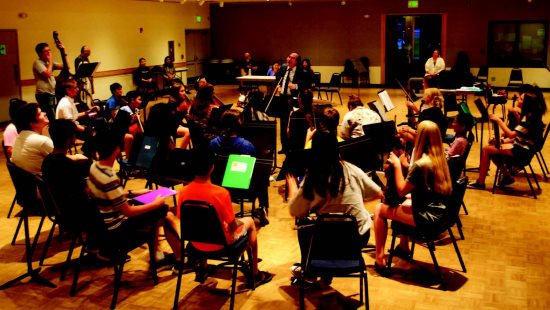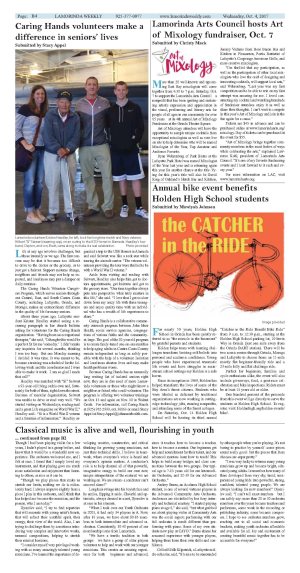|
|
Published October 4th, 2017
|
Classical music is alive and well, flourishing in youth
|
|
| By B. B. Kaye |
 |
| Rem Djemilev works with his orchestra. Photo B.B. Kaye |
If one accepts commercial broadcasts as exclusive representatives of culture, one could well miss the resurging interest in classical music.
 Young musicians file into the performance space at the Center for Community Arts in Walnut Creek every Tuesday, unpack, rosin their bows or assemble their wind instruments, and settle into chairs.
Young musicians file into the performance space at the Center for Community Arts in Walnut Creek every Tuesday, unpack, rosin their bows or assemble their wind instruments, and settle into chairs.
 Always first in the room, Rem Djemilev has been sorting scores. He beams, welcoming arriving players, checking that they have what they need, and showing younger ones how to adjust their bows or tune. He makes sure everyone has sheet music, and rushes to the office for copies if needed. His zest is infectious, and as players warm up their cheerful and frenetic energy turns expectant and focused.
Always first in the room, Rem Djemilev has been sorting scores. He beams, welcoming arriving players, checking that they have what they need, and showing younger ones how to adjust their bows or tune. He makes sure everyone has sheet music, and rushes to the office for copies if needed. His zest is infectious, and as players warm up their cheerful and frenetic energy turns expectant and focused.
 Djemilev conducts the Intermediate and Advanced Community Arts Orchestras in Walnut Creek, helping children from surrounding towns to build collaborative and creative skills. Orchestra members may have any degree of the usual uncertainties of youth but, as session begins, there is a profound transformation in the whole.
Djemilev conducts the Intermediate and Advanced Community Arts Orchestras in Walnut Creek, helping children from surrounding towns to build collaborative and creative skills. Orchestra members may have any degree of the usual uncertainties of youth but, as session begins, there is a profound transformation in the whole.
 Rem Djemilev treats them as equals, and they respond as such. The result is a youth orchestra capable of passionately performing advanced works by composers such as Antonin Dvorak and Dmitri Shostakovich, as well as popular and film music, with a virtuosity that many adult orchestras find challenging. The full orchestras hold two or three concerts per season, winter and summer.
Rem Djemilev treats them as equals, and they respond as such. The result is a youth orchestra capable of passionately performing advanced works by composers such as Antonin Dvorak and Dmitri Shostakovich, as well as popular and film music, with a virtuosity that many adult orchestras find challenging. The full orchestras hold two or three concerts per season, winter and summer.
 Lafayette middle school student Katrina Ortman has been an orchestra member for six years. "When I first joined, I was pretty nervous. What if I messed up? What if I wasn't good enough? On the other hand, I was really excited. Though I had been playing violin for a few years, I hadn't played in a group before, and knew that it would be a wonderful new experience. The orchestra welcomed me, and I felt at ease. I found that I simply loved my instrument, and that playing gave me much more satisfaction and enjoyment than listening to others, as nice as it can be.
Lafayette middle school student Katrina Ortman has been an orchestra member for six years. "When I first joined, I was pretty nervous. What if I messed up? What if I wasn't good enough? On the other hand, I was really excited. Though I had been playing violin for a few years, I hadn't played in a group before, and knew that it would be a wonderful new experience. The orchestra welcomed me, and I felt at ease. I found that I simply loved my instrument, and that playing gave me much more satisfaction and enjoyment than listening to others, as nice as it can be.
 "Though we play pieces that make us stretch our limits, nothing we do is ridiculously hard. I always improve slightly from a piece I play in this orchestra, and I think that has helped me become the musician, and the person, who I am today."
"Though we play pieces that make us stretch our limits, nothing we do is ridiculously hard. I always improve slightly from a piece I play in this orchestra, and I think that has helped me become the musician, and the person, who I am today."
 Djemilev said, "I try to find repertoire that will resonate with young artist's hearts, that will reflect their youthful spirit, their energy, their view of the world. Also, I am trying to challenge them by sometimes introducing very complex and innovative works, unusual compositions, helping to stretch their musical horizons.
Djemilev said, "I try to find repertoire that will resonate with young artist's hearts, that will reflect their youthful spirit, their energy, their view of the world. Also, I am trying to challenge them by sometimes introducing very complex and innovative works, unusual compositions, helping to stretch their musical horizons.
 "I consider myself very privileged working with so many amazingly talented young musicians. I've learned the importance of developing creative, constructive, and critical thinking for growing young musicians, not just their technical skills. I believe in teamwork, where everyone's voice is heard and everyone's opinion matters. A conductor's role is to help channel all of that powerful, imaginative energy to build our own new, unique interpretation of the material we are working on. We are a team- a conductor can't succeed alone!"
"I consider myself very privileged working with so many amazingly talented young musicians. I've learned the importance of developing creative, constructive, and critical thinking for growing young musicians, not just their technical skills. I believe in teamwork, where everyone's voice is heard and everyone's opinion matters. A conductor's role is to help channel all of that powerful, imaginative energy to build our own new, unique interpretation of the material we are working on. We are a team- a conductor can't succeed alone!"
 Long hair swings into his boyish face and he smiles, flipping it aside. Cheerful and optimistic, always dressed in a suit, Djemilev is at ease in his element.
Long hair swings into his boyish face and he smiles, flipping it aside. Cheerful and optimistic, always dressed in a suit, Djemilev is at ease in his element.
 "When I took over our Youth Orchestra in 2001, it had only 14 players in it. Now, after 16 years, we have about 80-85 members in both intermediate and advanced orchestras. Consistently, 30-40 percent of our membership come from Lamorinda.
"When I took over our Youth Orchestra in 2001, it had only 14 players in it. Now, after 16 years, we have about 80-85 members in both intermediate and advanced orchestras. Consistently, 30-40 percent of our membership come from Lamorinda.
 "We have a terrific tradition in both groups - we have a group of older players volunteer to help and work with our younger musicians. This creates an amazing experience for both - beginners and advanced, since it teaches how to become a teacher, how to become a mentor. Our beginners get help and nourishment for their talent, and our advanced mentors learn how to teach! This helps to build many bridges and close connections between the two groups. Our typical age is 7-13 years old for our Intermediate Orchestra, and 12-19 for our Advanced Orchestra."
"We have a terrific tradition in both groups - we have a group of older players volunteer to help and work with our younger musicians. This creates an amazing experience for both - beginners and advanced, since it teaches how to become a teacher, how to become a mentor. Our beginners get help and nourishment for their talent, and our advanced mentors learn how to teach! This helps to build many bridges and close connections between the two groups. Our typical age is 7-13 years old for our Intermediate Orchestra, and 12-19 for our Advanced Orchestra."
 Audrey Burns, an Acalanes High School student, is one of several virtuoso players in the Advanced Community Arts Orchestra. Audiences are electrified by her fiery intensity and technical mastery. "I started playing piano at age 6," she said, "but what grabbed me about playing violin at Community Arts was the social aspect; performing with our full orchestra is much different than performing with piano. Some of my own students now play at CAYO." Burns shares her seasoned experience with younger players, helping them hone their own skills and confidence.
Audrey Burns, an Acalanes High School student, is one of several virtuoso players in the Advanced Community Arts Orchestra. Audiences are electrified by her fiery intensity and technical mastery. "I started playing piano at age 6," she said, "but what grabbed me about playing violin at Community Arts was the social aspect; performing with our full orchestra is much different than performing with piano. Some of my own students now play at CAYO." Burns shares her seasoned experience with younger players, helping them hone their own skills and confidence.
 Cellist Eilidh Kilpatrick, a Lafayette middle-schooler, said, "It's nice to be surrounded by other people when you're playing. It's not boring to practice by yourself -some pieces sound really good- but the pieces that Rem chooses are super pretty."
Cellist Eilidh Kilpatrick, a Lafayette middle-schooler, said, "It's nice to be surrounded by other people when you're playing. It's not boring to practice by yourself -some pieces sound really good- but the pieces that Rem chooses are super pretty."
 "I was very lucky to witness many young musicians grow up and become bright, educated young adults. I remember how many of them developed from very shy, timid, inexperienced young kids into powerful, strong, confident, talented young people. We are always looking for new members!" Djemilev said. "I can't tell exact numbers - but I can safely say: more than 20 or 30 orchestra members over the years became teachers and performers, some work in the recording or publishing industry, some became composers. I hope to see orchestra numbers grow, reaching out to all social and economic brackets, making youth orchestra affordable and available for all. Joy and excitement of creating beautiful music together has to be accessible for everyone!"
"I was very lucky to witness many young musicians grow up and become bright, educated young adults. I remember how many of them developed from very shy, timid, inexperienced young kids into powerful, strong, confident, talented young people. We are always looking for new members!" Djemilev said. "I can't tell exact numbers - but I can safely say: more than 20 or 30 orchestra members over the years became teachers and performers, some work in the recording or publishing industry, some became composers. I hope to see orchestra numbers grow, reaching out to all social and economic brackets, making youth orchestra affordable and available for all. Joy and excitement of creating beautiful music together has to be accessible for everyone!"


|
|
|
|
|
|
|
|
|
|
|
|
|
|




